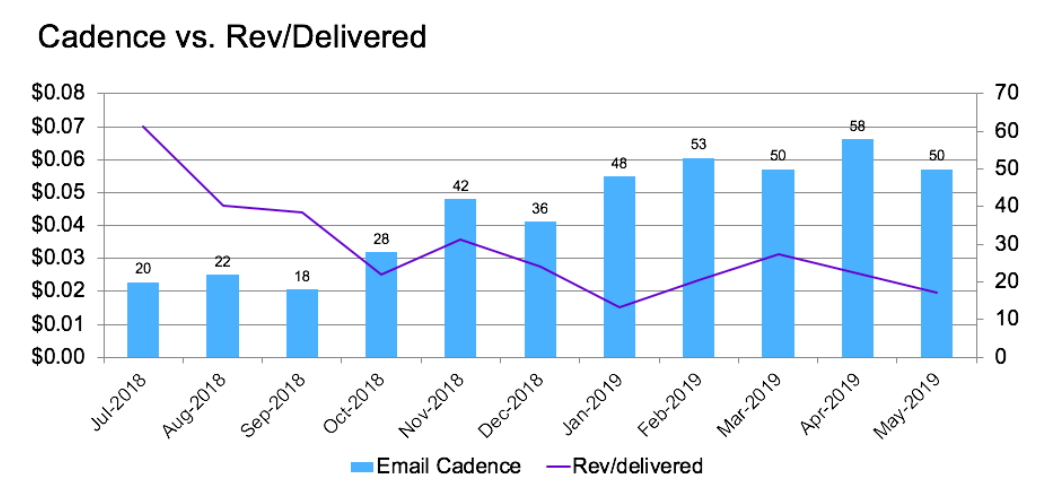The Case for Email Cadence

Email enthusiasts (and if you’re reading this, you’re one of us): Can we get a high five for thoughtful and responsible email sending?
Email is proven and profitable, with the highest ROI of any digital channel. Because email is relatively low cost and high reward, there is the temptation to go all in and send aggressively. Often an increase in email cadence can result in revenue gains for eCommerce brands, or a healthy boost in lead acquisition for B2B brands – in the short term. But the importance of balancing short-term gains against long-term program effects cannot be overstated.
We all know the struggle; it’s a very slippery slope from under-utilized to over-exposed. So how do you determine the “right” send amount? We’ve got you covered.
We’ve all heard it: Content is king. If the content you’re putting in front of your audience isn’t new or interesting, they’ll quickly lose trust in your brand and stop engaging with your emails. It is much more impactful to send thoughtful communication for significant milestones (sales/promotions, product launches, new features) than it is to send more emails with sub-par content.
Pro Tip: Review year-over-year analytics and identify your seasonal “high” times and promotions that did particularly well. Plan a long-term content calendar to support trends in your business, upcoming sales, and product launches. Consider seasonally-relevant increases in mailing cadence as opposed to mailing more all year.
If you’re seeing an increase in engagement, or even a steady trend, there may be an opportunity to start slowly increasing your sends to generate a lift in channel revenue. Be sure you have a good handle on how your email metrics fluctuate throughout the year to ensure any increase in cadence doesn’t pull opens, clicks, or conversions out of your brand’s sweet spot, and be ready to pull back if that happens.
Pro Tip: Implement a ramp-up strategy. Start with one extra send a week. If after a period of time you’re seeing engagement remain steady and channel revenue increase, add an additional send per week. Rinse and repeat.
You may have spent a lot of time and/or money creating buyer personas for your brand and crafting your messaging accordingly. Use that information to determine if your audience has a high threshold for an aggressive campaign schedule.
Pro Tip: Inventory your audience data and create separate send tracks for different demographics. Most brands have enough information to know where a contact falls in the funnel, basic demographic or location data, gender, and past browse and purchase behavior. Dreaming of more data? Consider an email campaign to collect segmentable information.
1. Key engagement metrics are on the decline.
Are your open rates or revenue per delivery decreasing at a steady rate? This may indicate that your audience is growing fatigued.

Pro Tip: To determine if cadence is to blame, create a holdout group of random contacts and pull back on the number of emails they receive each week. Compare results against your business-as-usual segment to find the frequency sweet spot for your audience.
2. Unsubscribes are piling up.
If you’re seeing an uptick in unsubscribe rates (and anything above .5% is generally considered high), or even a steady unsubscribe rate across multiple sends resulting in an increase in aggregate contacts lost, ask yourself: are short-term revenue gains significant enough to compensate for the potential loss of revenue from those contacts who opted out?
Pro Tip: Analyze the cost per acquisition and lifetime value of email contacts, and use that data to determine the actual cost and opportunity cost relative to the increase in unsubscribe rate. This relatively simple formula will allow you to make data-driven decisions that maximize short-term revenue without compromising the long-term health of your program.
3. You’re finding the need for deeper, more frequent discounts.
Your emails are making less per campaign, and now you’re compensating by sending more and charging less. Consider the impact to your margins.
Pro Tip: Shift your promotional strategy from aggressive discounts in batch sends to personalized offers in triggered sends. According to Experian, personalized emails deliver 6x higher transactional rates than non-personalized email. Store the unique code on the contact record and recycle it if it’s not used, preventing any one contact from engaging with too many offers.
4. Engagement windows are shrinking.
What’s the length of time between contact creation and when a contact stops opening your email? Are you seeing engagement decrease from a 90-day window to a 30-day window? Are you having to pull your engagement thresholds tighter on your segments to achieve similar results?
Pro Tip: Break your main list into segments based on age of contact, and periodically send to those segments. Track the key engagement metrics across each of these segments over time. Plot out the key drop-off points and see if metrics are declining with increased sends, particularly with recently added contacts.
5. Emails are landing in the Spam folder.
This can be the biggest hit to an email program. Most email providers consider subscriber engagement when determining whether an email should land in the inbox vs. the spam folder. The Bad News: If you’ve gained a bad sender reputation, it can be a long, hard journey back to the inbox. The Good News: there IS a way out.
Pro Tip: Review open rates by domain to determine which are experiencing the worst inbox placement rates. Target highly engaged audiences for those domains and ramp up slowly, deploying relevant and engaging content to increase your engagement ratio. Use an inbox reputation tool to measure any changes in inbox placement rate, and use that data to further refine your segments. Rethink your sending strategy.
Position your company for healthy, sustainable growth by taking a big-picture view of your email program. Looking to level-up your email program but rethinking the cadence increase? Increase the ROI from your emails without mailing more by harnessing the power of 1:1 communication with your email contacts instead.
